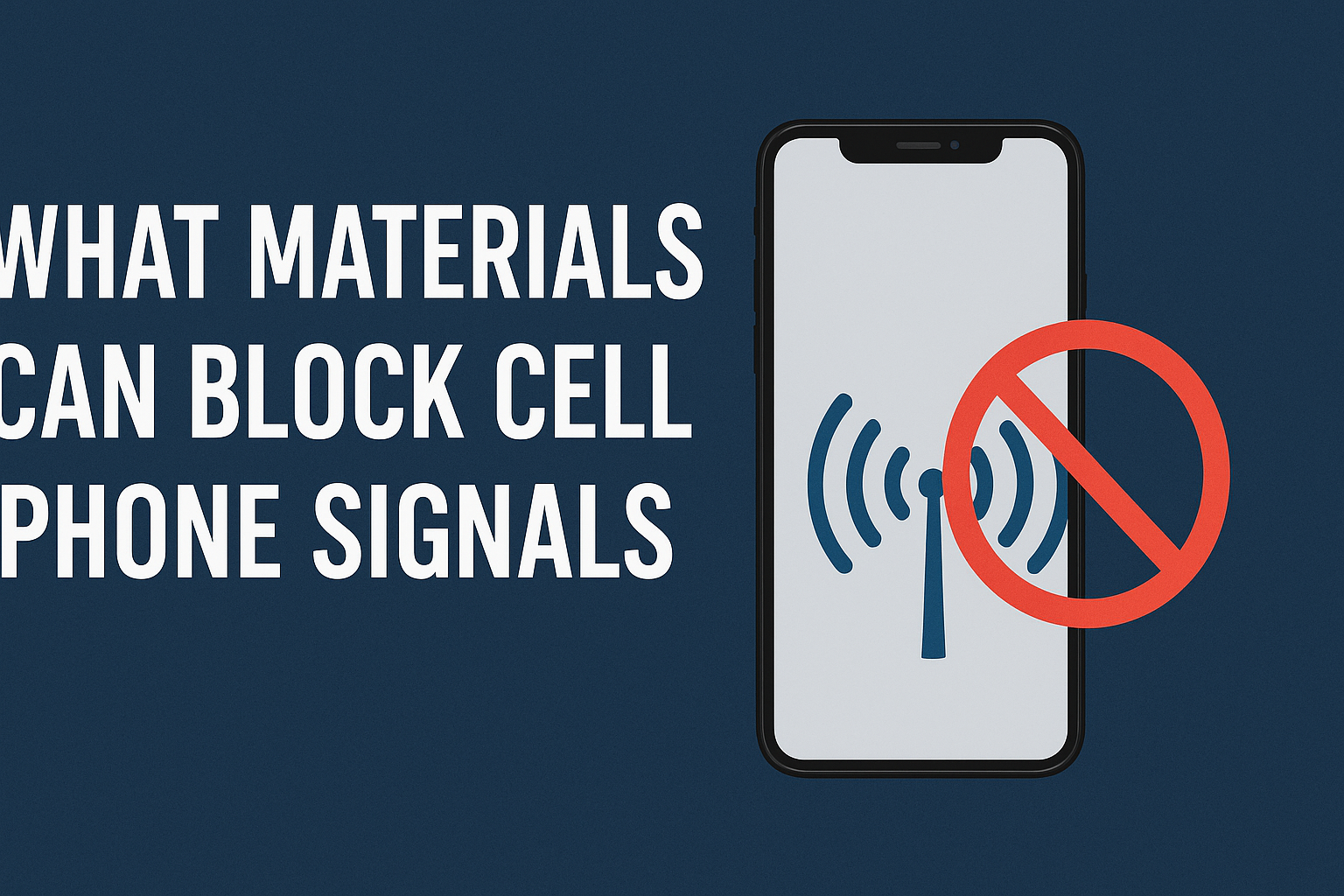How radio signals travel (quick primer)
Cell phones use radio waves to talk to cell towers and Wi-Fi routers. Those waves can sail through air, but many everyday materials slow them down, reflect them, or soak them up. Understanding which materials affect signals helps you design private spaces, troubleshoot reception problems, or decide when a stronger control measure is appropriate – always with legality and safety first.
Common Materials That Block or Weaken Cell Signals
Below are some of the most common materials that can interfere with mobile phone, Wi-Fi, or GPS signals. The strength of the blockage depends on the material’s density, metal content, and moisture level.
| Material | How It Affects Signals | Effectiveness |
|---|---|---|
| Metal (steel, aluminum, copper, foil) | Reflects and absorbs radio waves – basically turns a space into a mini Faraday cage. | ⭐⭐⭐⭐ |
| Reinforced concrete | Dense and full of metal rebar, making it one of the strongest natural barriers. | ⭐⭐⭐ |
| Stone or brick walls | Thick, heavy, and moisture-resistant – good at slowing down wireless signals. | ⭐⭐⭐ |
| Plaster or drywall (with metal mesh) | Can absorb higher frequencies and reduce coverage indoors. | ⭐⭐ |
| Wood or plywood | Doesn’t completely block, but slightly weakens high-frequency signals like 5G. | ⭐ |
| Tinted or coated glass | Metal oxide coatings reflect light and radio frequencies. | ⭐⭐ |
| Fiberglass or metal-coated insulation | Often used in modern buildings – can cause patchy Wi-Fi and cell reception. | ⭐⭐ |
| Trees and thick vegetation | Moisture in leaves absorbs microwave signals, especially when wet. | ⭐⭐ |
| Hills and natural terrain | Block direct line-of-sight transmission – major cause of dead zones. | ⭐⭐⭐⭐ |
In short: If it’s metal, dense, or wet, it can probably block or weaken your phone’s connection.
Legal and responsible ways to reduce or control signals
It’s important to be clear: different jurisdictions have different rules. Rather than suggesting unilateral or risky action, here are practical, responsible options – plus guidance on when stronger, authorized controls may be appropriate.
1. Passive shielding (safe, low-risk)
- Faraday bagsand metal containers – perfect for temporarily storing phones, GPS Tags or keys when you want them truly offline. Easy, cheap, and noninvasive.
- Shielding paint, mesh or films – conductive wall coatings and window films can significantly reduce signal ingress when installed by professionals and properly grounded. Ideal for conference rooms, labs, or sensitive facilities.
- Building choices – basements, thick concrete rooms, or spaces with metal infrastructure naturally have poor reception and are often used intentionally for privacy or testing.
2. Controlled, authorized use of signal management tools
- Authorized equipment in regulated settings: In some industries and places, licensed or government-approved signal control devices are used legitimately – for example, by military units, law enforcement with proper warrants and procedures, correctional facilities under the law, or production/test labs where radio silence is part of safety or testing protocols.
- If you believe a jammer or active signal-blocking device is necessary, use consumer jammers only within the scope and locations permitted by law and with appropriate safety and interference mitigation measures in place.
Why this caution matters: Active signal suppression can disrupt public safety communications, emergency calls, or neighboring services. Managing that risk requires proper authorization, technical safeguards, and professional oversight.
3. Operational policies and tech alternatives
- Phone-free zones and policies – signage, staff training, and device collection in secure pouches accomplish much without technical intervention.
- Network management – in corporate or campus environments, IT teams can control access via managed Wi-Fi, VPNs, or mobile device management (MDM) policies.
- Physical design – using metalized partitions, controlled entry points, and designated secure rooms can offer reliable signal control without active radio suppression.
Typical use cases for signal control (and how to approach them legally)
- Confidential meetings or R&D tests: Use shielded rooms, grounding, and Faraday enclosures; if active suppression is needed, obtain authorization and use certified systems.
- Correctional facilities and exam halls: Many places operate under specific laws that permit managed signal control – always follow the governing regulations.
- Asset protection (anti-tracking): Faraday pouches for keys, trackers or phones are a simple privacy tool.
- Safety testing & laboratories: Shielded chambers are standard; these are installed by specialists and documented for compliance.
Short checklist before you act
- Is passive shielding enough? Try Faraday bags (as FSB03), metal containers or shielding films first.
- Does your intended action require authorization? If any active suppression is considered, consult regulators and legal counsel.
- Hire professionals for installation or for purchasing systems that claim to control signals – ask for compliance documentation.
- Protect safety and emergency access – ensure your measures won’t block emergency services or critical comms.
Final thoughts
You don’t need dramatic measures to manage wireless connectivity. Thoughtful use of materials (metal, dense masonry, Low-E glass) and passive tools (Faraday bags, shielding coatings) often solves the problem. When stronger controls are genuinely needed, make sure they’re used only in regulated, authorized circumstances with the right technical and legal safeguards.

